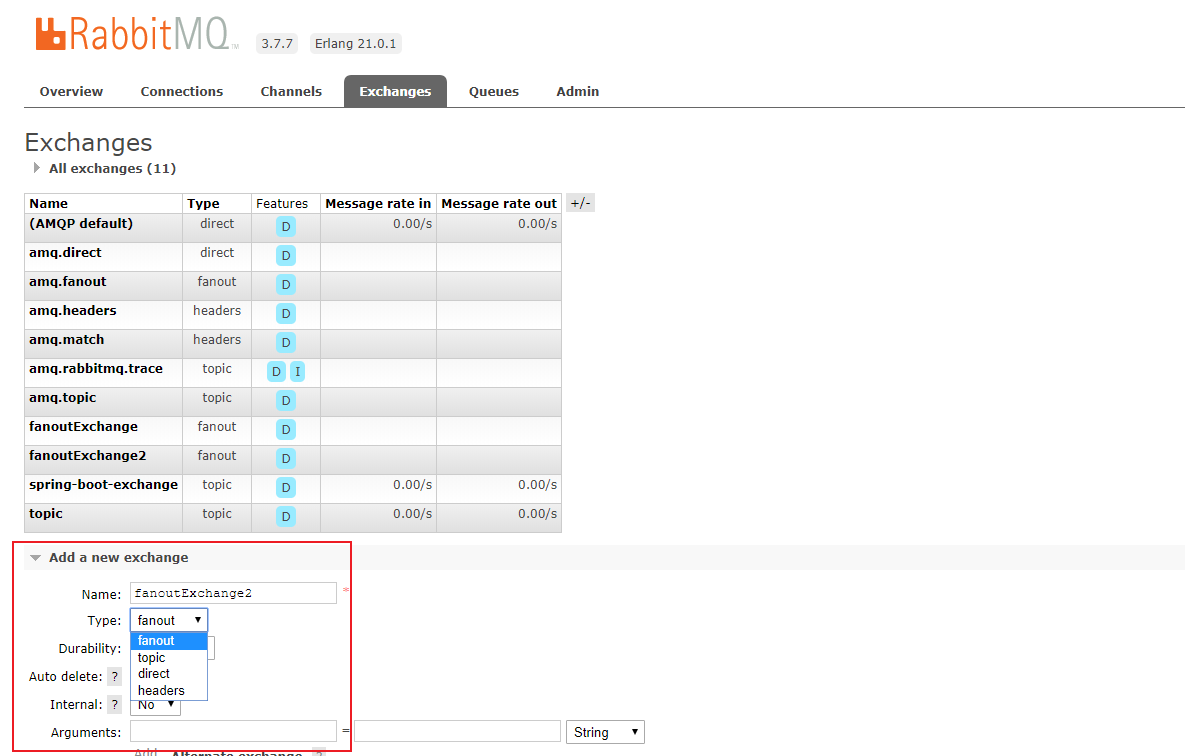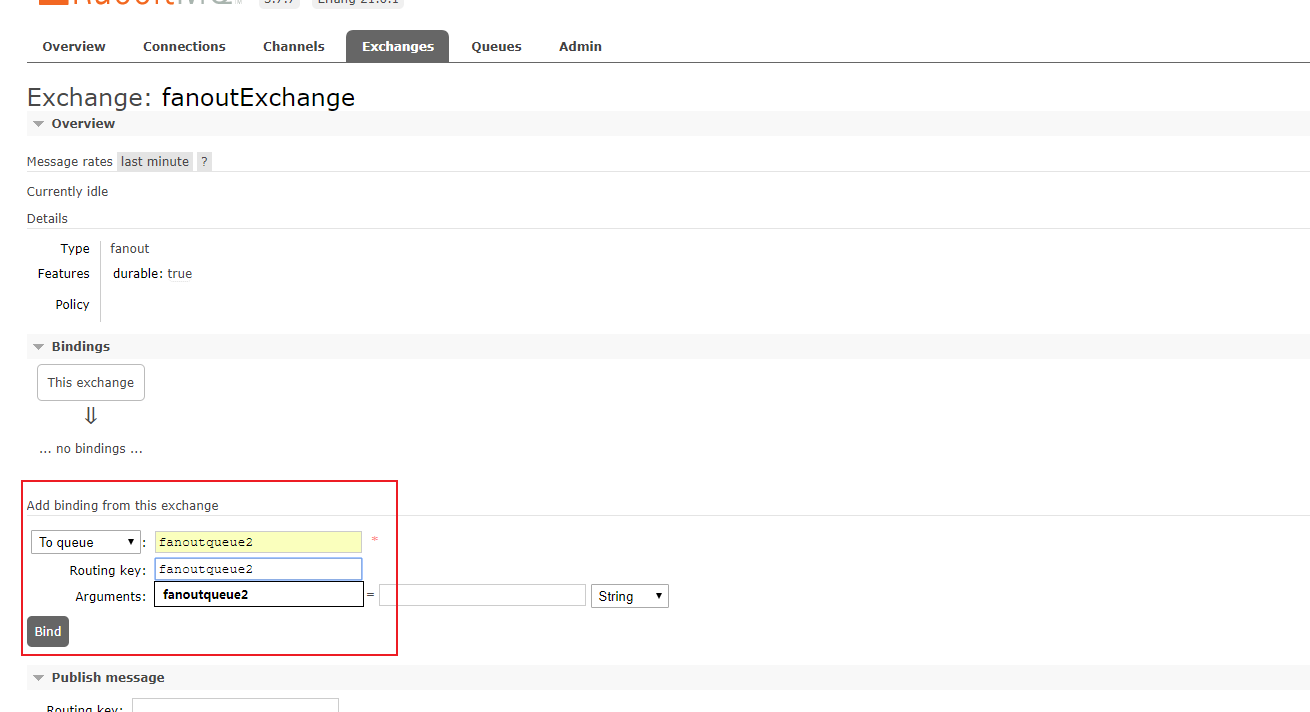RabbitMQ简介与springboot整合

1.什么是消息队列
消息队列,主要解决异步消息的管理(注册后,短信发送不是必须,可以使用队列)。实现系统之间的双向解耦,同时也能起到消息缓冲,消息分发的作用。当生产者产生大量数据,而消费者无法快速消费,(秒杀数据量过大使系统崩溃,队列可以废弃多余请求),或者是消费者异常了(服务挂掉后使请求丢失,队列可以保存请求)。
说白话讲,主要作用就是异步,削峰与解耦。
1.rabbitMQ简介
1.运行流程

rabbitmq是消息队列的一种,通过上图可以看到工作流程。生产者把请求给交换机 ,交换机把请求按照一定绑定关系发送给队列(平均发送),然后队列在把请求给消费者。其中交换机只负责转发并不负责保存,然后通过绑定关系与队列相绑定。交换器按照路由键绑定队列。当多消费者消费一个队列时,队列会均匀的发送到多个消费者之中。
其中
- 生产者为发送消息的服务/类。
- 消费者是接收消息的服务/类。
- 交换机将接收到的消息按照交换机类型发送给队列。
- 未被消费的消息都被存放在队列中。
2.交换机类型
rabbitmq提供了四种交换机。
- fanout:发送给所有绑定该交换机的队列。
- Direct:默认的交换方法,按照提供的key去寻找队列。如果key为A,数据只能发送到A的队列中。
- Topic:模糊匹配,只要符合该格式就可以。可以存在两种特殊字符“”与“#”,用于做模糊匹配,其中“”用于匹配一个单词,“#”用于匹配多个单词(可以是零个)。如*.C.# 可以匹配A.C.B.不能匹配A.B.C.(其中以banding key关联)
- head:根据消息内容中的headers属性进行匹配。
3.使用的工具类
ConnectionFactory、Connection、Channel都是RabbitMQ对外提供的API中最基本的对象。Connection是RabbitMQ的socket链接,它封装了socket协议相关部分逻辑。ConnectionFactory为Connection的制造工厂。
Channel是我们与RabbitMQ打交道的最重要的一个接口,我们大部分的业务操作是在Channel这个接口中完成的,包括定义Queue、定义Exchange、绑定Queue与Exchange、发布消息等。
4.spring boot 整合rabbitmq
代码思路:在配置文件中定义队列(queue),交换机(exchange),然后队列与交换器以路由键名称相对应(路由键和队列名相匹配,既以路由键寻找对列名),然后生产者可以通过交换器和队列名称确定要发送的队列,而消费者选择监控队列,来获取消息。
在整合之前需要安装rabbitmq,然后启动和搭建框架。
1.Direct交换机
1.新建队列与绑定关系
@Configuration
public class RabbitMQConfig {
// -------------------------topic队列
// 创建队列
@Bean
public Queue topicQueue() {
return new Queue("topic.mess");
}
}
- 1
- 2
- 3
- 4
- 5
- 6
- 7
- 8
- 9
- 10
2.生产者
直接配置一个队列,然后调用API发送消息就可以了。
public class ProducerController {
@Autowired
private RabbitTemplate rabbitTemplate;
@GetMapping("/sendMessage")
public Object sendMessage() {
new Thread(() -> {
//for (int i = 0; i < 100; i++) {
Date date = new Date();
String value = new SimpleDateFormat("yyyy-MM-dd hh:mm:ss").format(date);
System.out.println("send message {}" + value);
City city= new City();
city.setCityName("aaaa");
city.setDescription("bbb");
city.setProvinceId((long)111);
rabbitTemplate.convertAndSend("topic.mess", city); //使用默认的队列
//}
}).start();
return "ok";
}
}
- 1
- 2
- 3
- 4
- 5
- 6
- 7
- 8
- 9
- 10
- 11
- 12
- 13
- 14
- 15
- 16
- 17
- 18
- 19
- 20
- 21
- 22
- 23
3.消费者
消费者直接使用就可以了(可以传对象 基本类型)。需要@RabbitListener注解。
@Component
@RabbitListener(queues = "topic.mess") //topic交换机
public class Consumer2 {
@RabbitHandler
public void consumeMessage(City city) {
System.out.println("consume message {} 2222222:" + city);
}
}
- 1
- 2
- 3
- 4
- 5
- 6
- 7
- 8
- 9
2.topic交换机
1.新建队列与绑定关系
声名两个队列和一个topic交换器,然后通过路由键绑定他们之间的关系,路由键和队列名相同就能匹配,但是topic可以模糊匹配 #可以代替一段字符。
@Configuration
public class RabbitMQConfig {
// -------------------------topic队列
// 创建队列
@Bean
public Queue topicQueue() {
return new Queue("topic.mess");
}
@Bean
public Queue topicQueue2() {
return new Queue("topic.mess2");
}
// 创建 topic 类型的交换器
@Bean
public TopicExchange topicExchange() {
return new TopicExchange("topic");
}
// 使用路由键(routingKey)把队列(Queue)绑定到交换器(Exchange) Topic交换器通过routingKey与队列绑定
@Bean
public Binding bindingA(Queue topicQueue, TopicExchange topicExchange) {
return BindingBuilder.bind(topicQueue).to(topicExchange).with("topic.mess");
}
@Bean
public Binding bindingB(Queue topicQueue2, TopicExchange topicExchange) {
return BindingBuilder.bind(topicQueue2).to(topicExchange).with("topic.#");
}
}
- 1
- 2
- 3
- 4
- 5
- 6
- 7
- 8
- 9
- 10
- 11
- 12
- 13
- 14
- 15
- 16
- 17
- 18
- 19
- 20
- 21
- 22
- 23
- 24
- 25
- 26
- 27
- 28
- 29
- 30
- 31
- 32
- 33
2.生产者
直接调用API发送消息。消费者发送到队列,因为有模糊匹配的规则,topic.mess可以匹配 topic.mess和topic.mess2队列 而topic.mess2只能匹配到topic.#。
@RestController
public class ProducerController {
@Autowired
private RabbitTemplate rabbitTemplate;
@GetMapping("/sendMessage")
public Object sendMessage() {
new Thread(() -> {
//for (int i = 0; i < 100; i++) {
Date date = new Date();
String value = new SimpleDateFormat("yyyy-MM-dd hh:mm:ss").format(date);
System.out.println("send message {}" + value);
City city= new City();
city.setCityName("aaaa");
city.setDescription("bbb");
city.setProvinceId((long)111);
rabbitTemplate.convertAndSend("topic", "topic.mess", city);
rabbitTemplate.convertAndSend("topic", "topic.mess2", city);
//}
}).start();
return "ok";
}
}
- 1
- 2
- 3
- 4
- 5
- 6
- 7
- 8
- 9
- 10
- 11
- 12
- 13
- 14
- 15
- 16
- 17
- 18
- 19
- 20
- 21
- 22
- 23
- 24
3.消费者
消费者直接接收。
@Component
@RabbitListener(queues = "topic.mess") //topic交换机
public class Consumer2 {
@RabbitHandler
public void consumeMessage(City city) {
System.out.println("consume message {} 2222222:" + city);
}
}
- 1
- 2
- 3
- 4
- 5
- 6
- 7
- 8
- 9
3.Fanout Exchange 广播
1.新建队列与绑定关系
在配置文件中声名队列和交换器,然后绑定。
// --------FanoutExchange绑定
// -------------------------Fanout 队列
@Bean
FanoutExchange fanoutExchange() {
return new FanoutExchange("fanoutExchange");
}
@Bean
public Queue fanoutQueue() {
return new Queue("fanoutqueue");
}
@Bean
public Queue fanoutQueue2() {
return new Queue("fanoutqueue2");
}
@Bean
public Binding bindingC(Queue fanoutQueue, FanoutExchange fanoutExchange) {
return BindingBuilder.bind(fanoutQueue).to(fanoutExchange);
}
@Bean
public Binding bindingD(Queue fanoutQueue2, FanoutExchange fanoutExchange) {
return BindingBuilder.bind(fanoutQueue2).to(fanoutExchange);
}
- 1
- 2
- 3
- 4
- 5
- 6
- 7
- 8
- 9
- 10
- 11
- 12
- 13
- 14
- 15
- 16
- 17
- 18
- 19
- 20
- 21
- 22
2.生产者
调用API发送消息。
@RestController
public class ProducerController {
@Autowired
private RabbitTemplate rabbitTemplate;
@GetMapping("/sendMessage")
public Object sendMessage() {
new Thread(() -> {
//for (int i = 0; i < 100; i++) {
Date date = new Date();
String value = new SimpleDateFormat("yyyy-MM-dd hh:mm:ss").format(date);
System.out.println("send message {}" + value);
City obj = new City();
obj.setCityName("aaaa");
obj.setDescription("bbb");
obj.setProvinceId((long)111);
rabbitTemplate.convertAndSend("fanoutExchange","", value); //使用默认的队列
//}
}).start();
return "ok";
}
}
- 1
- 2
- 3
- 4
- 5
- 6
- 7
- 8
- 9
- 10
- 11
- 12
- 13
- 14
- 15
- 16
- 17
- 18
- 19
- 20
- 21
- 22
- 23
- 24
3.消费者
然后接收,所有绑定队列的都可以接收到。
@Component
@RabbitListener(queues = "fanoutqueue2")
public class Consumer {
@RabbitHandler
public void consumeMessage(String message) {
System.out.println("consume message {} 1111111:" + message);
}
}
- 1
- 2
- 3
- 4
- 5
- 6
- 7
- 8
- 9
5.页面新建队列
还可以在http://localhost:15672/#/exchanges中直接配置队列和交换机绑定关系。(略微有点麻烦,不建议使用)
1.新建队列

2.新建交换机

3.新增绑定关系
绑定交换器和队列之间的关系 ,然后就可以直接使用了,并不需要java内部声名使用。

文章来源: baocl.blog.csdn.net,作者:小黄鸡1992,版权归原作者所有,如需转载,请联系作者。
原文链接:baocl.blog.csdn.net/article/details/121146076
- 点赞
- 收藏
- 关注作者


评论(0)